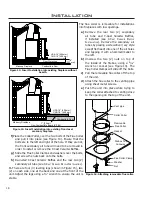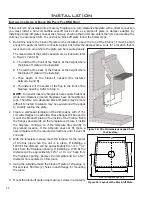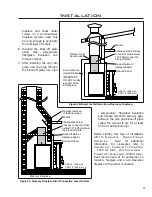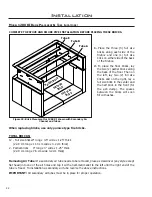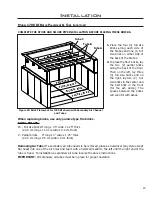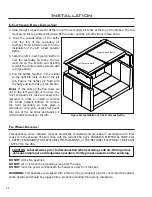
Operating Instructions
5. Why won’t my fire light?
Damp or wet wood and a poor draft are the main reasons for poor results in starting a fire. Always use
dry, seasoned wood for your fire. Even wood dried for two years will be difficult to ignite if it has become
wet from rain.
6. Is it normal for soot to cover the glass at the beginning of a fire?
Your stove has been built with an air-wash system that will help keep the glass clear when the firebox
has reached a good operating temperature and has a good draft. Normally a hot stove will keep the glass
clean. If you must clean the glass, use a soft non abrasive cloth and clean with water when unit is cold.
Cold firebox temperature and poor draft cause sooting of the glass. Once the firebox temperature and
the draft increase, the soot should burn off.
7. What is draft?
Draft is the ability of the chimney to exhaust or draw smoke produced during the normal combustion
process. Too much draft may cause excessive temperatures in the appliance and may damage the
appliance. Inadequate draft may cause back puffing or “plugging” of the chimney. There is a certain
amount of draft that is required to allow for your stove to function at its’ highest efficiency. A water
column reading of 0.1” or more is recommended.
8. What can cause a poor draft?
The most common factors for poor draft are:
a) Lack of supply air b) Environmental conditions
c) Cold chimney temperature
d) Poor chimney installation and maintenance
e) Atmospheric pressure
a) Air supply – Inside the home, normal household appliances such as clothes dryers and forced-air
furnaces compete for air, resulting in air starvation to the wood stove. This creates a condition in the
house known as negative pressure. When a house experiences negative pressure, the combustion
gases can be drawn from the chimney and into the house. This condition is commonly referred to as
down-drafting. Increased amounts of insulation, vinyl windows, extra caulking in various places and
door seals can all keep heat in but may also make a home too airtight. An easy way to stop negative
pressure in a home is to crack a window in the room containing the stove.
b) Environmental Conditions - High trees, low-lying house location such as in a valley, tall buildings or
structures surrounding your house and windy conditions can cause poor draft or down drafting.
c) Cold Chimney Temperature - Avoid cold chimney temperatures by burning a hot fire for the first fifteen
to forty minutes, being careful not to over-fire the stove. If any part of the chimney or parts of the
stove start to glow, you are over-firing the stove. If possible,
d) Chimney Installation and Maintenance - Avoid using too many elbows or long horizontal runs. If your
chimney is too short it can cause difficult start-up, dirty glass, reduced heat, and down drafting when
door is open. Too tall a chimney may prompt excessive draft, which can result in very short burn times
and excessive heat output. If in doubt, contact a chimney expert and/or chimney manufacturer for
help. To reduce the chance of draw issues and chimney fires regularly clean the chimney, rain cap,
and spark arrestor.
Note
: These instructions are intended as an aid and do not supercede any local, provincial or state
requirements. Check with officials or authorities having jurisdiction in your area.
9. How can I reduce the visible emissions?
If all of these steps are followed, there should be no visible emissions.
9
Summary of Contents for Kodiak 1200 FPI
Page 30: ...Notes 30 ...


















